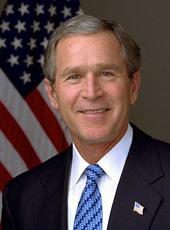On October 9, 2004, the Afghan people made history when they held their nation's first direct presidential election. Parliamentary elections are scheduled for next spring.
"The Afghan people are showing extraordinary courage under difficult conditions… They've adopted a constitution that protects the rights of all, while honoring their nation's most cherished traditions. More than 10 million Afghan citizens – over 4 million of them women – are now registered to vote … To any who still would question whether Muslim societies can be democratic societies, the Afghan people are giving their answer."
-- President Bush, September 21, 2004
The Election Process: Key Facts
- According to the United Nations, more than 10 million Afghans registered to vote in spite of uncertain security and attacks on some polling sites and election workers. 41 percent of registered voters were women.
- The government of Afghanistan and the United Nations formed the Joint Electoral Management Body (JEMB) to supervise the election and ensure a transparent and credible election process.
- 18 presidential candidates, including one female candidate, ran in the election.
- Polling took place at some 22,000 polling stations throughout Afghanistan, as well as in Afghan refugee camps in Pakistan and Iran. There were some 600,000 eligible voters in Iran and more than 700,000 in Pakistan.
- To ensure that no one voted more than once, each voter's right index finger was stained with a long-lasting ink before the voter left the polling station. In addition, each voter's registration card number was recorded and his or her card punched.
- International monitors and support teams from the European Union, the Organization for Security and Cooperation in Europe, the United States, and the Asia Network for Free Elections traveled to Afghanistan for the election, joining Afghan observers.
- In order to ensure that ballots are counted in a transparent manner, the eight tabulation centers have been opened to the media. Because of the ruggedness of the terrain, the remoteness of many towns and villages in the country, and the need to ensure transparent and credible counting of the paper ballots, it could take up to four weeks to tabulate the official results.
- A run-off election will take place between the two top candidates if no candidate receives a majority of the vote. If necessary, a run-off would be held two weeks after the official results are certified.
- The United States worked closely with Afghan leaders and international partners in preparing for this historic election. The United States to date has provided $78 million (40 percent) of the $198 million needed to prepare for and carry out the election.
The Long March to Elections
- Afghan representatives from all over the country came together in a Loya Jirga (or grand council) in 2003 to choose an interim government and establish procedures for adopting a constitution.
- A draft constitution was distributed throughout Afghanistan in 2003, and Afghans from all walks of life joined the official Constitutional Debate.
- In the autumn of 2003, meetings were held at the local and provincial levels to select delegates for the Loya Jirga meeting in December to debate the draft and adopt the new constitution. More than 90 of the 500 delegates participating in the Loya Jirga were women.
- The Constitutional Loya Jirga convened on December 14, 2003, and after three weeks of debate, negotiation, and compromise, it approved a new constitution on January 4, 2004.
- The constitution establishes a democracy with an executive branch and a bicameral legislature. The lower house will be chosen by direct elections, while the upper house will be evenly divided between representatives selected by provisional councils, representatives selected by district councils, and presidential appointees. Checks and balances exist between the branches of government.
- President Karzai signed a new electoral law on May 25, 2004.
George W. Bush, Fact Sheet: Elections in Afghanistan Online by Gerhard Peters and John T. Woolley, The American Presidency Project https://www.presidency.ucsb.edu/node/282082

